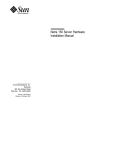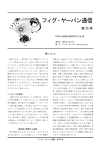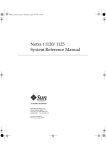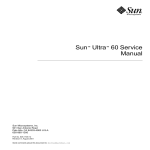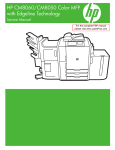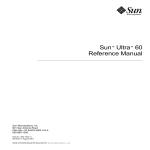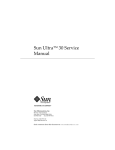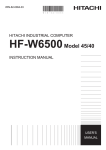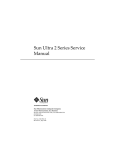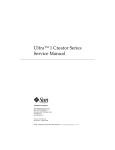Download Sun Ultra 2 Series Reference Manual
Transcript
Sun Ultra 2 Series Reference Manual Sun Microsystems Computer Company A Sun Microsystems, Inc. Business 901 San Antonio Road Palo Alto, CA 94303-4900 USA 650 960-1300 fax 650 969-9131 Part No.: 802-2562-11 Revision A, May 1996 1997 Sun Microsystems, Inc., 901 San Antonio Road, Palo Alto, California 94303-4900 U.S.A. All rights reserved. This product or document is protected by copyright and distributed under licenses restricting its use, copying, distribution, and decompilation. No part of this product or document may be reproduced in any form by any means without prior written authorization of Sun and its licensors, if any. Portions of this product may be derived from the UNIX® system, licensed from Novell, Inc., and from the Berkeley 4.3 BSD system, licensed from the University of California. UNIX is a registered trademark in the United States and in other countries and is exclusively licensed by X/Open Company Ltd. Third-party software, including font technology in this product, is protected by copyright and licensed from Sun’s suppliers. RESTRICTED RIGHTS: Use, duplication, or disclosure by the U.S. Government is subject to restrictions of FAR 52.227-14(g)(2)(6/87) and FAR 52.227-19(6/87), or DFAR 252.227-7015(b)(6/95) and DFAR 227.7202-3(a). Sun, Sun Microsystems, the Sun logo, and Solaris are trademarks or registered trademarks of Sun Microsystems, Inc. in the United States and in other countries. All SPARC trademarks are used under license and are trademarks or registered trademarks of SPARC International, Inc. in the United States and in other countries. Products bearing SPARC trademarks are based upon an architecture developed by Sun Microsystems, Inc. The OPEN LOOK® and Sun™ Graphical User Interfaces were developed by Sun Microsystems, Inc. for its users and licensees. Sun acknowledges the pioneering efforts of Xerox Corporation in researching and developing the concept of visual or graphical user interfaces for the computer industry. Sun holds a nonexclusive license from Xerox to the Xerox Graphical User Interface, which license also covers Sun’s licensees who implement OPEN LOOK GUIs and otherwise comply with Sun’s written license agreements. THIS PUBLICATION IS PROVIDED “AS IS” WITHOUT WARRANTY OF ANY KIND, EITHER EXPRESS OR IMPLIED, INCLUDING, BUT NOT LIMITED TO, THE IMPLIED WARRANTIES OF MERCHANTABILITY, FITNESS FOR A PARTICULAR PURPOSE, OR NONINFRINGEMENT. Copyright 1997 Sun Microsystems, Inc., 901 San Antonio Road, Palo Alto, Californie 94303-4900 U.S.A. Tous droits réservés. Ce produit ou document est protégé par un copyright et distribué avec des licences qui en restreignent l’utilisation, la copie et la décompilation. Aucune partie de ce produit ou de sa documentation associée ne peut être reproduite sous aucune forme, par quelque moyen que ce soit, sans l’autorisation préalable et écrite de Sun et de ses bailleurs de licence, s’il y en a. Des parties de ce produit pourront être derivées du système UNIX® licencié par Novell, Inc. et du système Berkeley 4.3 BSD licencié par l’Université de Californie. UNIX est une marque enregistrée aux Etats-Unis et dans d’autres pays, et licenciée exclusivement par X/Open Company Ltd. Le logiciel détenu par des tiers, et qui comprend la technologie relative aux polices de caractères, est protégé par un copyright et licencié par des fournisseurs de Sun. Sun, Sun Microsystems, le logo Sun, et Solaris sont des marques déposées ou enregistrées de Sun Microsystems, Inc. aux Etats-Unis et dans d’autres pays. Toutes les marques SPARC, utilisées sous licence, sont des marques déposées ou enregistrées de SPARC International, Inc. aux Etats-Unis et dans d’autres pays. Les produits portant les marques SPARC sont basés sur une architecture développée par Sun Microsystems, Inc. Les utilisateurs d’interfaces graphiques OPEN LOOK® et Sun™ ont été développés de Sun Microsystems, Inc. pour ses utilisateurs et licenciés. Sun reconnaît les efforts de pionniers de Xerox Corporation pour la recherche et le développement du concept des interfaces d’utilisation visuelle ou graphique pour l’industrie de l’informatique. Sun détient une licence non exclusive de Xerox sur l’interface d’utilisation graphique, cette licence couvrant aussi les licenciés de Sun qui mettent en place les utilisateurs d’interfaces graphiques OPEN LOOK et qui en outre se conforment aux licences écrites de Sun. CETTE PUBLICATION EST FOURNIE "EN L’ETAT" SANS GARANTIE D’AUCUNE SORTE, NI EXPRESSE NI IMPLICITE, Y COMPRIS, ET SANS QUE CETTE LISTE NE SOIT LIMITATIVE, DES GARANTIES CONCERNANT LA VALEUR MARCHANDE, L’APTITUDE DES PRODUITS A REPONDRE A UNE UTILISATION PARTICULIERE OU LE FAIT QU’ILS NE SOIENT PAS CONTREFAISANTS DE PRODUITS DE TIERS. Please Recycle Contents Preface ix How This Book Is Organized x Using UNIX Commands x Typographic Conventions xi Shell Prompts xi Related Books xiii Sun Documentation on the Web xiii Sun Welcomes Your Comments xiii 1. Back Panel Connectors 1-1 1.1 Connector Layout 1-1 1.2 Serial Connectors 1-3 1.3 Parallel Connector 1.4 Keyboard/Mouse Connector 1.5 Media Independent Interface (MII) Connector 1.6 Twisted-Pair Ethernet (TPE) Connector 1.7 SCSI Connector 1.8 1-4 1-5 1-7 1-8 1.7.1 SCSI Implementation 1.7.2 SCSI Cabling and Configuration Audio Ports 1-6 1-9 1-10 1-11 iii 2. 3. 4. 5. iv 1.9 Audio Specifications 1-12 1.10 Graphics Card 13W3 Video Connector 1-13 10BASE-T Twisted-Pair Ethernet Link Test 2-1 2.1 Overview 2-1 2.2 Technical Discussion 2.3 Troubleshooting 2.4 Moves and Changes 2.5 Checking or Disabling the Link Test 2.6 Enabling the Link Test 2-6 Modem Setup Specifications 3-1 3.1 Setting Up the Modem 3-1 3.2 Serial Port Speed Change 3.3 Recommendations 2-3 2-4 2-5 2-5 3-2 3-2 3.3.1 Cable 3-2 3.3.2 Modem Switch Settings (AT Commands) Main Logic Board Jumpers 4.1 Identifying Jumpers 4.2 Flash PROM Jumpers 4.3 Serial Port Jumpers System Specifications 4-1 4-3 4-3 4-4 5-1 5.1 Power 5-1 5.2 Environment 5.3 Physical Specifications 5.4 Memory Mapping 5-2 5-3 Sun Ultra 2 Series Reference Manual • May 1996 5-3 3-3 Figures FIGURE P-1 Ultra 2 Series Nameplates FIGURE P-2 Ultra Enterprise 2 Nameplate FIGURE 1-1 Back Panel Switches and Connectors FIGURE 1-2 DB-25 Serial Connectors 1-3 FIGURE 1-3 DB-25 Parallel Connector 1-4 FIGURE 1-4 DIN-8 Keyboard/Mouse Connector 1-5 FIGURE 1-5 40-Pin Miniature-D MII Connector FIGURE 1-6 RJ-45 TPE Connector FIGURE 1-7 68-Pin SCSI Connector FIGURE 1-8 Connecting External Mass Storage Devices FIGURE 1-9 Audio Port Locations 1-11 FIGURE 1-10 13W3 Video Connector 1-13 FIGURE 2-1 Hosts and Hub in a Local Area Network 2-2 FIGURE 2-2 Ensuring Host-Hub Communication in a 10BASE-T Network 2-3 FIGURE 4-1 Jumper Locations on the Main Logic Board 4-2 FIGURE 4-2 Identifying Jumper Pins ix x 1-2 1-6 1-7 1-8 1-10 4-3 v vi Sun Ultra 2 Series Reference Manual • May 1996 Tables TABLE P-1 Typographic Conventions xi TABLE P-2 Shell Prompts xi TABLE P-3 Related Books xiii TABLE 1-1 Serial Connector Pinouts, RS-423/RS-232 TABLE 1-2 Parallel Connector Pinouts 1-4 TABLE 1-3 Keyboard/Mouse Connector Pinouts TABLE 1-4 MII Connector Pinouts TABLE 1-5 TPE Connector Pinouts 1-7 TABLE 1-6 68-Pin SCSI Connector Pinout 1-8 TABLE 1-7 Audio Port Signals 1-11 TABLE 1-8 Audio Port Functions TABLE 1-9 Audio Inputs and Output TABLE 1-10 Internal Monaural Speaker Specifications 1-12 TABLE 1-11 13W3 Video Connector Pinouts TABLE 4-1 Flash PROM Jumper Settings 4-4 TABLE 4-2 Serial Port Jumper Settings TABLE 5-1 Power Specifications TABLE 5-2 Environmental Specifications (Operating) TABLE 5-3 Environmental Specifications (Nonoperating) TABLE 5-4 Dimensions and Weight 5-3 1-3 1-5 1-6 1-11 1-12 1-13 4-4 5-1 5-2 5-2 vii viii TABLE 5-5 Physical Clearances 5-3 TABLE 5-6 Main Logic Board Memory Mapping Sun Ultra 2 Series Reference Manual • May 1996 5-3 Preface The Sun Ultra 2 Series Reference Manual contains useful information about the use and maintenance of a Sun™ Ultra™ 2 Series system. This book is for use with Ultra 2, Ultra 2 Creator, Ultra 2 Creator 3D, and Ultra Enterprise 2 systems only. The nameplate on your system front panel must be like the nameplate(s) shown in FIGURE P-1 or FIGURE P-2. FIGURE P-1 Ultra 2 Series Nameplates ix FIGURE P-2 Ultra Enterprise 2 Nameplate How This Book Is Organized Chapter 1 provides the location of each back panel connector and gives the pinouts for each connector. Chapter 2 presents a full tutorial about connecting the system to a 10BASE-T twisted-pair Ethernet (TPE} local area network (LAN). Chapter 3 gives modem settings for Sun Ultra 2 Series systems used in specific network telecommunication applications. Chapter 4 gives the locations and pin definitions of user-configurable main-logic board jumpers. Chapter 5 gives system requirements about power and environment, and also gives system dimension, weight, and memory mapping specifications. Using UNIX Commands This document may not contain information on basic UNIX® commands and procedures such as shutting down the system, booting the system, and configuring devices. x Sun Ultra 2 Series Reference Manual • May 1996 See one or more of the following for this information: ■ ■ ■ Solaris 2.x Handbook for SMCC Peripherals (If you are incorporating Solaris 2.x software commands in your document, delete this sentence.) AnswerBook™ online documentation for the Solaris™ 2.x software environment Other software documentation that you received with your system Typographic Conventions TABLE P-1 Typographic Conventions Typeface or Symbol Meaning Examples AaBbCc123 The names of commands, files, and directories; on-screen computer output. Edit your .login file. Use ls -a to list all files. % You have mail. AaBbCc123 What you type, when contrasted with on-screen computer output. % su Password: AaBbCc123 Book titles, new words or terms, words to be emphasized. Command-line variable; replace with a real name or value. Read Chapter 6 in the User’s Guide. These are called class options. You must be root to do this. To delete a file, type rm filename. Shell Prompts TABLE P-2 Shell Prompts Shell Prompt C shell machine_name% xi TABLE P-2 xii Shell Prompts Shell Prompt C shell superuser machine_name# Bourne shell and Korn shell $ Bourne shell and Korn shell superuser # Sun Ultra 2 Series Reference Manual • May 1996 Related Books The following documents contain topics that relate to the information in the Sun Ultra 2 Series Reference Manual. TABLE P-3 Related Books Application Title Part Number Installation Sun Ultra 2 Series Hardware Setup Instructions 802-5933 Installation Sun Ultra 2 Series Installation Guide 802-5934 Service Sun Ultra 2 Series Service Manual 802-2561 Sun Documentation on the Web The docs.sun.com web site enables you to access Sun technical documentation on the World Wide Web. You can browse the docs.sun.com archive or search for a specific book title or subject at: http://docs.sun.com. Sun Welcomes Your Comments We are interested in improving our documentation and welcome your comments and suggestions. You can email your comments to us at: [email protected]. Please include the part number of your document in the subject line of your email. xiii xiv Sun Ultra 2 Series Reference Manual • May 1996 CHAPTER 1 Back Panel Connectors 1.1 Connector Layout See the following figure. 1-1 Serial Connectors RS-423/RS-232 Keyboard/ Mouse Connector SBus Slots 1, 0 SBus Slots 3, 2 UPA Slot Graphics/Video Output — UPA Slot MII Connector Parallel Connector SCSI Connector Power On/Standby Switch TPE Connector Audio Connectors Headphones — Line Out — Line In — Microphone FIGURE 1-1 1-2 Back Panel Switches and Connectors Sun Ultra 2 Series Reference Manual • May 1996 1.2 Serial Connectors 13 1 25 14 13 1 25 14 A B FIGURE 1-2 DB-25 Serial Connectors TABLE 1-1 Serial Connector Pinouts, RS-423/RS-232 Pin Function I/O Signal Description 1 none none Not connected 2 TxD O Transmit Data 3 RxD I Receive Data 4 RTS O Ready To Send 5 CTS I Clear To Send 6 DSR I Data Set Ready 7 Gnd 8 DCD I Data Carrier Detect 9-14 none none Not connected 15 TRxC I Transmit Clock 16 none none Not connected 17 RTxC I Receive Clock 18-19 none none Not connected 20 DTR O Data Terminal Ready 21-23 none none Not connected 24 TxC O Transmit Clock 25 none none Not connected Signal Ground Chapter 1 Back Panel Connectors 1-3 1.3 Parallel Connector 13 1 25 1-4 FIGURE 1-3 DB-25 Parallel Connector TABLE 1-2 Parallel Connector Pinouts 14 Pin Description Pin Description 1 Data_Strobe_L 14 nAutoFd 2 Data[1] 15 nFault 3 Data[2] 16 nInit 4 Data[3] 17 nSelectln 5 Data[4] 18 Signal Ground 6 Data[5] 19 Signal Ground 7 Data[6] 20 Signal Ground 8 Data[7] 21 Signal Ground 9 Data[8] 22 Signal Ground 10 nAck 23 Signal Ground 11 Busy 24 Signal Ground 12 PError 25 Signal Ground 13 Select Sun Ultra 2 Series Reference Manual • May 1996 1.4 Keyboard/Mouse Connector 7 8 5 6 4 2 3 1 FIGURE 1-4 DIN-8 Keyboard/Mouse Connector TABLE 1-3 Keyboard/Mouse Connector Pinouts Pin Description Pin Description 1 Ground 5 Keyboard Out 2 Ground 6 Keyboard In 3 +5 VDC 7 Power Key In 4 Mouse In 8 +5 VDC Note – All signals are standard TTL levels. The +5V supply is fuse-protected. Chapter 1 Back Panel Connectors 1-5 1.5 1-6 Media Independent Interface (MII) Connector 20 1 40 21 FIGURE 1-5 40-Pin Miniature-D MII Connector TABLE 1-4 MII Connector Pinouts Pin Function Pin Function 1 +5V 21 +5V 2 MDIO 22 Signal Ground 3 MDC 23 Signal Ground 4 RXD<3> 24 Signal Ground 5 RXD<2> 25 Signal Ground 6 RXD<1> 26 Signal Ground 7 RXD<0> 27 Signal Ground 8 RX_DV 28 Signal Ground 9 RX_CLK 29 Signal Ground 10 RX_ER 30 Signal Ground 11 TX_ER 31 Signal Ground 12 TX_CLK 32 Signal Ground 13 TX_EN 33 Signal Ground 14 TXD<0> 34 Signal Ground 15 TXD<1> 35 Ground 16 TXD<2> 36 Ground 17 TXD<3> 37 Ground Sun Ultra 2 Series Reference Manual • May 1996 TABLE 1-4 1.6 MII Connector Pinouts (Continued) Pin Function Pin Function 18 COL 38 Signal Ground 19 CRS 39 Signal Ground 20 +5V 40 +5V Twisted-Pair Ethernet (TPE) Connector 8 FIGURE 1-6 RJ-45 TPE Connector TABLE 1-5 TPE Connector Pinouts 1 Pin Description Pin Description 1 Transmit Data + 5 Common Mode Termination 2 Transmit Data - 6 Receive Data - 3 Receive Data + 7 Common Mode Termination 4 Common Mode Termination 8 Common Mode Termination Chapter 1 Back Panel Connectors 1-7 1.7 SCSI Connector 34 68 1-8 FIGURE 1-7 68-Pin SCSI Connector TABLE 1-6 68-Pin SCSI Connector Pinout 1 35 Pin Signal Name Pin Signal Name 1 Ground 21 Ground 2 Ground 22 Ground 3 Ground 23 Ground 4 Ground 24 Ground 5 Ground 25 Ground 6 Ground 26 Ground 7 Ground 27 Ground 8 Ground 28 Ground 9 Ground 29 Ground 10 Ground 30 Ground 11 Ground 31 Ground 12 Ground 32 Ground 13 Ground 33 Ground 14 Ground 34 Ground 15 Ground 35 -DB<12> 16 Ground 36 -DB<13> 17 TERMPWR 37 -DB<14> 18 TERMPWR 38 -DB<15> 19 Not connected 39 -PAR<1> 20 Ground 40 -DB<0> 41 -DB<1> 63 -REQ 42 -DB<2> 53 Reserved Sun Ultra 2 Series Reference Manual • May 1996 TABLE 1-6 68-Pin SCSI Connector Pinout (Continued) Pin Signal Name Pin Signal Name 43 -DB<3> 54 Ground 44 -DB<4> 55 -ATN 45 -DB<5> 56 Ground 46 -DB<6> 57 -BSY 47 -DB<7> 58 -ACK 48 -PAR<0> 59 -RST 49 Ground 60 -MSG 50 TERM.DIS 64 -IO 51 TERMPWR 65 -DB<8> 52 TERMPWR 66 -DB<9> 61 -SEL 67 -DB<10> 62 -CD 68 -DB<11> Note – All signals shown in 1.7.1 TABLE 1-6 are active low. SCSI Implementation ■ ■ ■ ■ Single-ended 16-bit (wide SCSI) with parity 20 MBytes/sec Fast Wide SCSI Supports 16 SCSI addresses: Target 0-6 and 8-F for devices Target 7 reserved for SCSI host adapter on main-logic board Supports up to 3 internal SCSI drives: ■ ■ ■ SCSI disk drive target 0 (lower drive slot) SCSI disk drive target 1 (upper drive slot) ■ SCSI CD-ROM drive target 6 or SCSI tape drive target 5 External 8-bit and 16-bit SCSI devices supported via 68-pin SCSI connector ■ ■ ■ Chapter 1 Back Panel Connectors 1-9 1.7.2 SCSI Cabling and Configuration When mixing 8-bit and 16-bit SCSI devices on the same physical SCSI bus, follow these cabling and configuration guidelines to insure proper device addressing and operation: ■ If all external mass storage devices use 68-pin connectors, connect all non-Sun devices to the Ultra 2 Series system first and follow them with Sun devices. Sun devices use autotermination. ■ If external mass storage devices consist of 68-pin Sun devices and 50-pin devices, connect the Sun 68-pin devices to the Ultra 2 Series system first and terminate the daisy chain with the 50-pin device and its terminator. See the following figure for a summary of cabling and configuration guidelines. Ultra 2 series Non-Sun device 68—68 Non-Sun device Sun device 68—68 68—68 68—68 Ultra 2 series Sun device Sun device 50-pin device 68—50 68—68 Terminator Adapter cable FIGURE 1-8 1-10 Connecting External Mass Storage Devices Sun Ultra 2 Series Reference Manual • May 1996 T 1.8 Audio Ports Audio Ports: Headphones — Line Out — Line In — Microphone FIGURE 1-9 Audio Port Locations All audio ports use EIA standard 3.5-mm (0.125-inch) jacks. TABLE 1-7 Audio Port Signals Headphones Line Out Line In Microphone Tip Left Channel Left Channel Left Channel Left Channel Ring (Center) Right Channel Right Channel Right Channel Right Channel Shield Ground Ground Ground Ground TABLE 1-8 Audio Port Functions Port Function Headphones Connects stereophonic headphones for private listening of audio output Line Out Connects the system audio output to an external stereophonic amplifier and loudspeakers Line In Connects external stereophonic audio sources such as a compact disc player or cassette tape player to the system Microphone Connects the SunMicrophone II (or other suitable microphone1) to the system Chapter 1 Back Panel Connectors 1-11 1. The Ultra 2 Series microphone port accepts stereophonic input; however, the Sun Microphone II is a monophonic device. Note also that the older SunMicrophone is not compatible with the Ultra 2 Series system. 1.9 Audio Specifications The specifications in the following table assume use of the Audio Tool format setting “CD-ROM or DAT” selected. TABLE 1-10 lists the internal monaural speaker specifications. The microphone input specifications are for the SunMicrophone II. TABLE 1-9 Audio Inputs and Output Stereo I/Os Specifications Line In 2V typical, 4V max.; 5-50-ohm impedance Frequency Response 20 Hz-17 kHz +/- 0.5 dB Internal CD Input Input Level 0.1 percent Vrms typical at 10 kohms; 2Vpp max. Distortion 0.01 percent, typical at 1 kHz S/N Ratio 84 dB, typical IEC 179 A-weighted Frequency Response 20 Hz-17 kHz +/- 0.5 dB Microphone Input 15 mV typical, 0.6-1.0 kohm impedance; +5 VDC input bias via a 2.2 kohms resistor Headphones Output 1V typical, 2.4V max.; 16 kohms to 1 kohm impedance Line Out 1V typical, 2.4V max.; 5-50 kohms impedance TABLE 1-10 1-12 Internal Monaural Speaker Specifications Speaker Specifications Power Output 1.5W ave., 3W peak Distortion 0.02 percent typical at 1 kHz Impedance 16 ohms +/- 20 percent Frequency Response 150 Hz-17 kHz +/- 0.5 dB Sun Ultra 2 Series Reference Manual • May 1996 1.10 Graphics Card 13W3 Video Connector 1 5 A1 6 FIGURE 1-10 10 A2 A3 13W3 Video Connector The graphics card for your system provides the 13W3 video connector for transmitting video output signals from the system unit to the monitor. See the following table for 13W3 video connector pinouts. TABLE 1-11 13W3 Video Connector Pinouts Pin Function I/O Level A1 Red O Analog A2 Green O Analog A3 Blue O Analog 1 Serial Read 2 Vert Sync O TTL 3 Sense <0> I TTL 4 Ground 5 Comp Sync O TTL 6 Horiz Sync O TTL 7 Serial Write 8 Sense <1> I TTL 9 Sense <2> I TTL 10 Ground TTL GND TTL GND Chapter 1 Back Panel Connectors 1-13 1-14 Sun Ultra 2 Series Reference Manual • May 1996 CHAPTER 2 10BASE-T Twisted-Pair Ethernet Link Test Read this chapter if you are connecting your Ultra 2 Series system to a 10BASE-T twisted-pair Ethernet (TPE) network. This chapter contains important information for getting your system to communicate correctly over a TPE network. If you have no experience with TPE networks, ask your system or network administrator to perform the procedures in this chapter. Note – This chapter does not apply to 100BASE-T networks. In such networks, the link test function must be enabled at both the host and the hub. If your host is connected to a 100BASE-T network, you must not disable the host link test function. 2.1 Overview ■ ■ ■ The twisted-pair Ethernet link integrity test is a function defined by the IEEE 802.3 10BASE-T specification. For a networked workstation (host) to communicate with a network hub, the link test state (enabled or disabled) must be the same on the host and hub. If either the host or hub does not share the link test enabled/disabled state of the other, then the host cannot communicate effectively with the hub, and the hub cannot communicate effectively with the host. The following figure gives an example of a star configuration local area network (LAN), showing the relationship of hosts to a hub. FIGURE 2-2 shows the importance of ensuring that the host and hub link test settings match in a 10BASE-T network. 2-1 Host Host Host Hub Ultra 2 Series (Host) Host Host FIGURE 2-1 2-2 Hosts and Hub in a Local Area Network Sun Ultra 2 Series Reference Manual • May 1996 Link Test Enabled (Default) 1 Two-Way Communication Hub Ultra 2 Series Link Test Enabled (Default) 1 Ultra 2 Series may boot successfully, but with “lost carrier” or “no carrier” error messages. Ultra 2 Series may boot successfully, but other hosts in the network cannot communicate with the Ultra 2 Series. Two-Way Communication Ultra 2 Series FIGURE 2-2 2.2 Link Test Enabled 1 Hub Ultra 2 Series Link Test Disabled (Reset) 0 Link Test Disabled 0 Hub Ultra 2 Series Link Test Disabled (Reset) 0 Link Test Enabled 1 Link Test Disabled 0 Hub Ensuring Host-Hub Communication in a 10BASE-T Network Technical Discussion The twisted-pair Ethernet link integrity test determines the state of the twisted-pair cable link between the host and the hub in a network. Both the host and hub regularly transmit a link test pulse. When either the host or hub has not received a Chapter 2 10BASE-T Twisted-Pair Ethernet Link Test 2-3 link test pulse within a certain amount of time (50-150 ms), it makes the transition from the link-pass state to the link-fail state and remains in the link-fail state until it once again receives regular link test pulses. The link integrity test is specific to twisted-pair Ethernet and is not applicable to the other physical layer implementations of IEEE 802.3 such as 10BASE5 (”thicknet”) or 10BASE2 (“thinnet”). The link test function at the host or hub is either enabled (link test enabled or 1) or disabled (link test disabled or 0). The IEEE 802.3 10BASE-T specification requires that the link test be enabled at both the host and the hub. Although link test disabled does not conform to the specification, it is often encountered in real-world 10BASE-T network installations. Some hubs from various vendors can exhibit any of the following: 2.3 ■ Link test is “hardwired” enabled—link test is always enabled. ■ Link test is “hardwired” disabled—link test is always disabled. ■ Link test is configurable—the network administrator may enable or disable link test. Troubleshooting If you have connected an Ultra 2 Series host to a hub using twisted-pair Ethernet cable and observe either “no carrier” messages or fail to communicate effectively with another host in the same network, look first at the hub. If it supports configurable link test, then make sure “link test enabled” is configured. This is usually done by setting a hardware switch. If the hub does not support configurable link test, then refer to the hub manufacturer’s documentation. Check to see if your hub is hardwired for link test disabled. If it is, you must follow the “Checking or Disabling the Link Test” procedure elsewhere in this chapter to disable the link test at your Ultra 2 Series host. 2-4 Sun Ultra 2 Series Reference Manual • May 1996 2.4 Moves and Changes If the Ultra 2 Series host is physically moved to another network location or if the hub is reconfigured, remember to refer back to FIGURE 2-2. Unless the new network relationship between the host and the hub is functional (that is, 1-1 link test enabledlink test enabled or 0-0 link test disabled-link test disabled), there will be no full, regular two-way communication between the host and the hub. 2.5 Checking or Disabling the Link Test To check the link test state of an Ultra 2 Series host: 1. If you do not see the ok prompt, press the Stop (L1)-a keys. 2. At the ok prompt, type: ok printenv tpe-link-test? tpe-link-test? true ok true The above screen shows the current link test state (true, or enabled), followed by the default state (true, or enabled). To disable the host’s link test function: 1. Type the following commands: ok setenv tpe-link-test? false tpe-link-test? = false ok reset-all 2. Boot the host and verify that the transceiver cable problem messages do not appear. Type either boot net or boot disk and press Return. Chapter 2 10BASE-T Twisted-Pair Ethernet Link Test 2-5 2.6 Enabling the Link Test 1. If you do not see the ok prompt, press the Stop (L1)-a keys. 2. At the ok prompt, type: ok printenv tpe-link-test? tpe-link-test? false ok true The above screen shows the current link test state (false, or disabled), followed by the default state (true, or enabled). 1. To enable the host’s link test function, type the following commands: ok setenv tpe-link-test? true tpe-link-test? = true ok reset-all 2. Boot the host and verify that the transceiver cable problem messages do not appear. Type either boot net or boot disk and press Return. 2-6 Sun Ultra 2 Series Reference Manual • May 1996 CHAPTER 3 Modem Setup Specifications 3.1 Setting Up the Modem Any modem compatible with U.S. Robotics‘ or CCITT V.24 can be connected to the Ultra 2 Series serial ports. Modems can be set up to function in one of three ways: ■ ■ ■ Dial out only Dial in only Bidirectional Calls To set up your modem: 1. Become superuser. Type admintool. % su Password: # admintool 2. Highlight Browse. 3. Select Serial Port. 4. Select Port A or Port B for your modem connection. 5. Select Edit. 6. Select Expert. 7. Open the Use Template menu, and select one of the following: Modem - Dial-Out Only Modem - Dial-In Only Modem - Bidirectional 3-1 8. Select Apply. 9. Set your modem auto-answer switch to one of the following: For Dial-Out Only, set the switch to Off. For Dial-In Only, set the switch to On. For Bidirectional, set the switch to On. 3.2 Serial Port Speed Change You must edit the /etc/remote file to change the speed of a serial port. 1. Become rootsuperuser, and type cd /etc. % su Password: # cd /etc 2. Type vi remote. 3. Type tip speed device-name. Typical speeds are 9600, 19200 to 38400 bps. The device name is the serial port name — for example, /dev/tty[a,b] or /dev/term/[a,b]. 4. Press Esc and type :wq to save your file change(s) and to exit from the vi text editor. 3.3 Recommendations 3.3.1 Cable For a modem-to-host (system) connection, use an RS-423/RS-232 straight-through cable with DB-25 male connectors at both ends. 3-2 Sun Ultra 2 Series Reference Manual • May 1996 3.3.2 Modem Switch Settings (AT Commands) ■ ■ Enable transmit flow control (AT&H1) [suggested setting] (Required for sending binary/8-bit data) Set link rate to fixed (Will not track modem data rate, AT&Bn; n = menu choice in modem manual.) ■ Set display result codes (ATQ0) ■ Set verbal result codes (ATV1) ■ Set result code subset (ATXn; n = option choice) ■ Save settings in NVRAM (AT&W) Note – The above settings are guidelines to help you get started quickly. Changes to these guidelines should be expected depending on your site requirements and the modem you are using. For additional information about modem switch settings, see the manual that came with your modem. Chapter 3 Modem Setup Specifications 3-3 3-4 Sun Ultra 2 Series Reference Manual • May 1996 CHAPTER 4 Main Logic Board Jumpers Jumper settings given in this chapter refer to etchings on the main logic board. Jumpers are labeled with the letter “J” followed by a four-digit number. See the following figure. 4-1 Back panel J2901 Fan DSIMM U slots: 0601,0701,0401,U0501 0602, 0702, 0402, 0502 0603, 0703, 0403, 0503 0604, 0704, 0404, 0504 Disk drive sd0 Disk drive sd1 Speaker Front panel FIGURE 4-1 4-2 Jumper Locations on the Main Logic Board Sun Ultra 2 Series Reference Manual • May 1996 Disk drive 0 + 1 CPU 1 J2701 LOWER J2801 UPA slot CD-ROM drive Diskette drive CPU 0 Power supply UPPER MIDDLE SBus slot 3 J3002 J2502 J2105 SBus slot 1 J3102 J2501 Fan J3201 J3001 SBus slot 2 SCSI J3202 J3101 SBus slot 0 MII J2104 Fan Fan Side panel J2203 J2503 J2204 Audio ports K/B TPE J2101 RJ45 NVRAM/TOD Parallel port 4.1 Identifying Jumpers Jumpers are marked on the main logic board with part numbers. For example, the serial port jumpers are marked J2104 and J2105. Jumper pins are located immediately adjacent to the part number. Pin 1 is marked with an asterisk in any of the positions shown in the following figure. J2XXX Part number Pins * * * * * FIGURE 4-2 4.2 * Identifying Jumper Pins Flash PROM Jumpers The Ultra 2 Series system uses flash PROMs. Flash PROMs permit the following: ■ Reprogramming of specific code blocks ■ Remote reprogramming of the PROM chip by a system administrator over a local area network The default shunt setting of J2002 is on pins 1 and 2. This selects the flash PROM chip as the controlling firmware device. See FIGURE 4-1. The default shunt setting of J2003 is on pins 1 and 2. This disables the flash PROM chip from being reprogrammed. Placing the shunt on pins 2 and 3 enables reprogramming of the flash PROM chip. Chapter 4 Main Logic Board Jumpers 4-3 Note – If you are reprogramming your system flash PROM, after successful reprogramming be sure to return the flash PROM Write Protect/Enable jumper (J2003) to the Write Protect position to increase system security. TABLE 4-1 Flash PROM Jumper Settings Jumper Pins 1 + 2 Select Pins 2 + 3 Select Default Jumper on Pins J2002 Flash PROM Not To Be Used 1+2 FLASH PROM SEL J2003 Write Protect Write Enable 1+2 FLASH PROM PROG ENABLE J2204 High Half Booting Normal Booting 2+3 XOR LOGIC SET Signal Controlled For flash PROM reprogramming information and the function of J2204, see the SMCC System Flash PROM Programming Guide. 4.3 Serial Port Jumpers The serial port jumpers on the main logic board permit configuring the two DB-25 serial ports on the system unit back panel for either RS-423 or RS-232 signal levels. RS-423 levels are the default standard for North American users. RS-232 levels are required for digital telecommunication in nations of the European Community. TABLE 4-2 4-4 Serial Port Jumper Settings Jumper Pins 1 + 2 Select Pins 2 + 3 Select Default Jumper on Pins J2104 RS-232 RS-423 2+3 RS232/RS423 SEL J2105 RS-232 RS-423 2+3 RS232/RS423 SEL Sun Ultra 2 Series Reference Manual • May 1996 Signal Controlled CHAPTER 5 System Specifications 5.1 Power The following table lists power specifications. TABLE 5-1 Power Specifications Input/Output Specifications AC Power Input 100-240 VAC nominal, 47-63 Hz. DC Power Output 350 W maximum 5-1 5.2 Environment The following specifications comply with the International Electromechanical Commission (IEC) Standards, 5th ed., 1990-1994. TABLE 5-2 Environmental Specifications (Operating) Operating Altitude without removable tape media 0 meters (0 feet) [sea level], 40 degrees C (104 degrees F) to 3000 meters (9840 feet), 34.6 degrees C (94.2 degrees F) — IEC 68-2-40 Altitude with removable tape media 0 meters (0 feet) [sea level], 35 degrees C (95 degrees F) to 3000 meters (9840 feet), 29.4 degrees C (84.9 degrees F) — IEC 68-2-40 Humidity 5% to 95% relative humidity (RH) regardless of temperature —IEC 68-2-02, 68-2-03 Shock 2.0G, 11 milliseconds, half sine pulse — IEC 68-2-27 Vibration 0.1G, 5 to 500 Hz, swept sine — IEC 68-2-06 Temperature 5 degrees C to 40 degrees C (41 degrees F to 104 degrees F) — IEC 68-2-01, 68-2-02 TABLE 5-3 Environmental Specifications (Nonoperating) Nonoperating 5-2 Altitude 0 to 12,000 meters (0 to 39,360 feet) — IEC 68-2-40 Humidity 0% to 93% RH at 40 degrees C (104 degrees F) — IEC 68-2-03 Shock 15 G peak, 11 milliseconds, half sine pulse — IEC 68-2-27 Vibration 0.5 G, 5 to 500 Hz, swept sine — IEC 68-2-06 Temperature 20 degrees C to 55 degrees C (-4 degrees F to 131 degres F) — IEC 68-2-01, 68-2-0 Sun Ultra 2 Series Reference Manual • May 1996 5.3 Physical Specifications TABLE 5-4 Dimensions and Weight Height Width Depth Weight 13.0 cm (5.12 in.) 45.0 cm (17.72 in.) 45.2 cm (17.94 in.) 15.88 kg (35.0 lb) TABLE 5-5 Physical Clearances Clearance Specification Compact Disc/Diskette 16.51 cm (6.5 in.) System Unit Parallel Placement 7.6 cm (3.0 in.)1 1. Physical space between two system units side by side 5.4 Memory Mapping Single in-line memory modules (SIMMs) are installed on the main logic board in groups of four. Identical SIMMs are installed in each group. TABLE 5-6 Main Logic Board Memory Mapping Memory Group Slots 0 U0501, U0701, U0401, U0601 1 U0502, U0702, U0402, U0602 2 U0503, U0703, U0403, U0603 3 U0504, U0704, U0404, U0604 Chapter 5 System Specifications 5-3 5-4 Sun Ultra 2 Series Reference Manual • May 1996















































